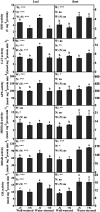Osmotic Adjustment and Antioxidant System Regulated by Nitrogen Deposition Improve Photosynthetic and Growth Performance and Alleviate Oxidative Damage in Dwarf Bamboo Under Drought Stress
- PMID: 35498701
- PMCID: PMC9047053
- DOI: 10.3389/fpls.2022.819071
Osmotic Adjustment and Antioxidant System Regulated by Nitrogen Deposition Improve Photosynthetic and Growth Performance and Alleviate Oxidative Damage in Dwarf Bamboo Under Drought Stress
Abstract
Dwarf bamboo (Fargesia denudata) is a staple food for the endangered giant pandas and plays a critical role in the sub-alpine ecosystem. Characterized by shallow roots and expeditious growth, it is exceedingly susceptible to drought stress and nitrogen (N) deposition in the context of a changing global environment. However, a comprehensive picture about the interactive response mechanism of dwarf bamboo to the two factors, water regime and N deposition, is far from being given. Therefore, a completely randomized design with two factors of water regimes (well-watered and water-stressed) and N deposition levels (with and without N addition) of F. denudata was conducted. In view of the obtained results, drought stress had an adverse impact on F. denudata, showing that it destroyed ultrastructure integrity and induced oxidative damage and restricted water status in leaves and roots, as well as declined photosynthetic efficiency in leaves, especially in N non-deposition plants. Nevertheless, F. denudata significantly increased heat dissipation in leaves, regulated antioxidant enzymes activities, antioxidants contents, and osmoregulation substances concentrations in leaves and roots, as well as shifted biomass partitioning in response to drought stress. However, regardless of water availability, N deposition maintained better ultrastructure in leaves and roots, resulting in superior photosynthesis and growth of F. denudata. Additionally, although N deposition did not cause oxidative damage in well-watered plants, ameliorated the effects of drought stress on F. denudata through co-deploying heat dissipation in leaves, the antioxidant system in roots as well as osmotic adjustment in leaves and roots. Noticeably, the leaves and roots of F. denudata expressed quite distinct acclimation responses to drought resistance under N deposition.
Keywords: Fargesia denudata; antioxidative defense system; drought stress; nitrogen deposition; osmotic adjustment.
Copyright © 2022 Wu, Tian, Ren and Wang.
Conflict of interest statement
The authors declare that the research was conducted in the absence of any commercial or financial relationships that could be construed as a potential conflict of interest.
Figures







Similar articles
-
Unveiling the Hidden Responses: Metagenomic Insights into Dwarf Bamboo (Fargesia denudata) Rhizosphere under Drought and Nitrogen Challenges.Int J Mol Sci. 2024 Oct 8;25(19):10790. doi: 10.3390/ijms251910790. Int J Mol Sci. 2024. PMID: 39409119 Free PMC article.
-
Effects of phosphorus application on photosynthetic carbon and nitrogen metabolism, water use efficiency and growth of dwarf bamboo (Fargesia rufa) subjected to water deficit.Plant Physiol Biochem. 2015 Nov;96:20-8. doi: 10.1016/j.plaphy.2015.07.018. Epub 2015 Jul 20. Plant Physiol Biochem. 2015. PMID: 26218549
-
Photoprotection regulated by phosphorus application can improve photosynthetic performance and alleviate oxidative damage in dwarf bamboo subjected to water stress.Plant Physiol Biochem. 2017 Sep;118:88-97. doi: 10.1016/j.plaphy.2017.05.022. Epub 2017 Jun 8. Plant Physiol Biochem. 2017. PMID: 28624684
-
The Synergistic Responses of Different Photoprotective Pathways in Dwarf Bamboo (Fargesia rufa) to Drought and Subsequent Rewatering.Front Plant Sci. 2017 Apr 4;8:489. doi: 10.3389/fpls.2017.00489. eCollection 2017. Front Plant Sci. 2017. PMID: 28421106 Free PMC article.
-
Photoprotective and antioxidative mechanisms against oxidative damage in Fargesia rufa subjected to drought and salinity.Funct Plant Biol. 2017 Feb;44(3):302-311. doi: 10.1071/FP16214. Funct Plant Biol. 2017. PMID: 32480565
Cited by
-
Mining Key Drought-Resistant Genes of Upland Cotton Based on RNA-Seq and WGCNA Analysis.Plants (Basel). 2025 May 8;14(10):1407. doi: 10.3390/plants14101407. Plants (Basel). 2025. PMID: 40430973 Free PMC article.
-
Unveiling the Hidden Responses: Metagenomic Insights into Dwarf Bamboo (Fargesia denudata) Rhizosphere under Drought and Nitrogen Challenges.Int J Mol Sci. 2024 Oct 8;25(19):10790. doi: 10.3390/ijms251910790. Int J Mol Sci. 2024. PMID: 39409119 Free PMC article.
-
Melatonin imparts tolerance to combined drought and high-temperature stresses in tomato through osmotic adjustment and ABA accumulation.Front Plant Sci. 2024 Mar 28;15:1382914. doi: 10.3389/fpls.2024.1382914. eCollection 2024. Front Plant Sci. 2024. PMID: 38606062 Free PMC article.
-
Functions of exogenous strigolactone application and strigolactone biosynthesis genes GhMAX3/GhMAX4b in response to drought tolerance in cotton (Gossypium hirsutum L.).BMC Plant Biol. 2024 Oct 26;24(1):1008. doi: 10.1186/s12870-024-05726-w. BMC Plant Biol. 2024. PMID: 39455926 Free PMC article.
-
Effects of Drought Stress on Leaf Functional Traits and Biomass Characteristics of Atriplex canescens.Plants (Basel). 2024 Jul 22;13(14):2006. doi: 10.3390/plants13142006. Plants (Basel). 2024. PMID: 39065532 Free PMC article.
References
-
- Agami R. A., Alamri S. A., Abd El-Mageed T., Abousekken M., Hashem M. (2018). Role of exogenous nitrogen supply in alleviating the deficit irrigation stress in wheat plants. Agric. Water Manag. 210, 261–270. doi: 10.1016/j.agwat.2018.08.034 - DOI
-
- Ali Z., Golombek S. (2016). Effect of drought and nitrogen availability on osmotic adjustment of five pearl millet cultivars in the vegetative growth stage. J. Agron. Crop Sci. 202, 433–444. doi: 10.1111/jac.12163 - DOI
-
- Arrigoni O., Dipierro S., Borraccino G. (1981). Ascorbate free radical reductase, a key enzyme of the ascorbic acid system. FEBS Lett. 125, 242–244. doi: 10.1016/0014-5793(81)80729-6 - DOI
-
- Azzeme A. M., Abdullah S. N. A., Aziz M. A., Wahab P. E. M. (2016). Oil palm leaves and roots differ in physiological response, antioxidant enzyme activities and expression of stress-responsive genes upon exposure to drought stress. Acta Physiol. Plant. 38, 52. doi: 10.1007/s11738-016-2073-2 - DOI
LinkOut - more resources
Full Text Sources

